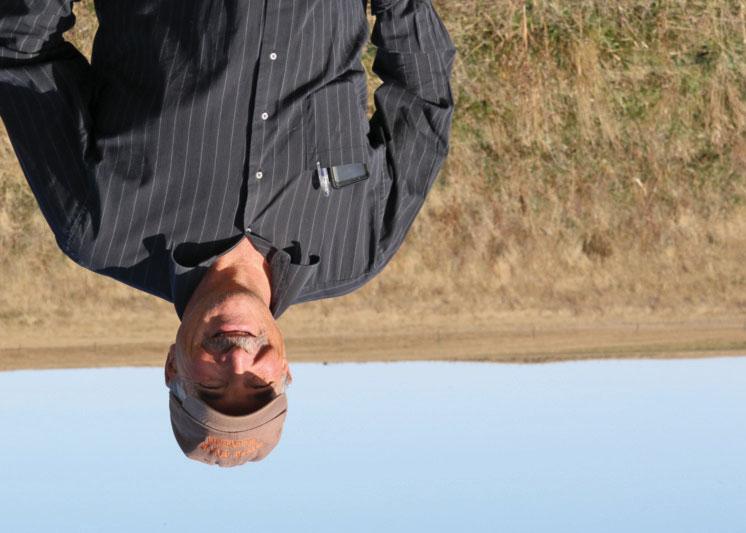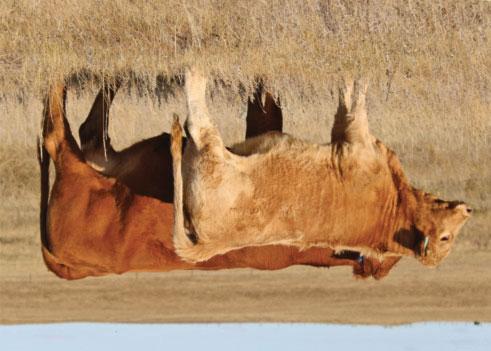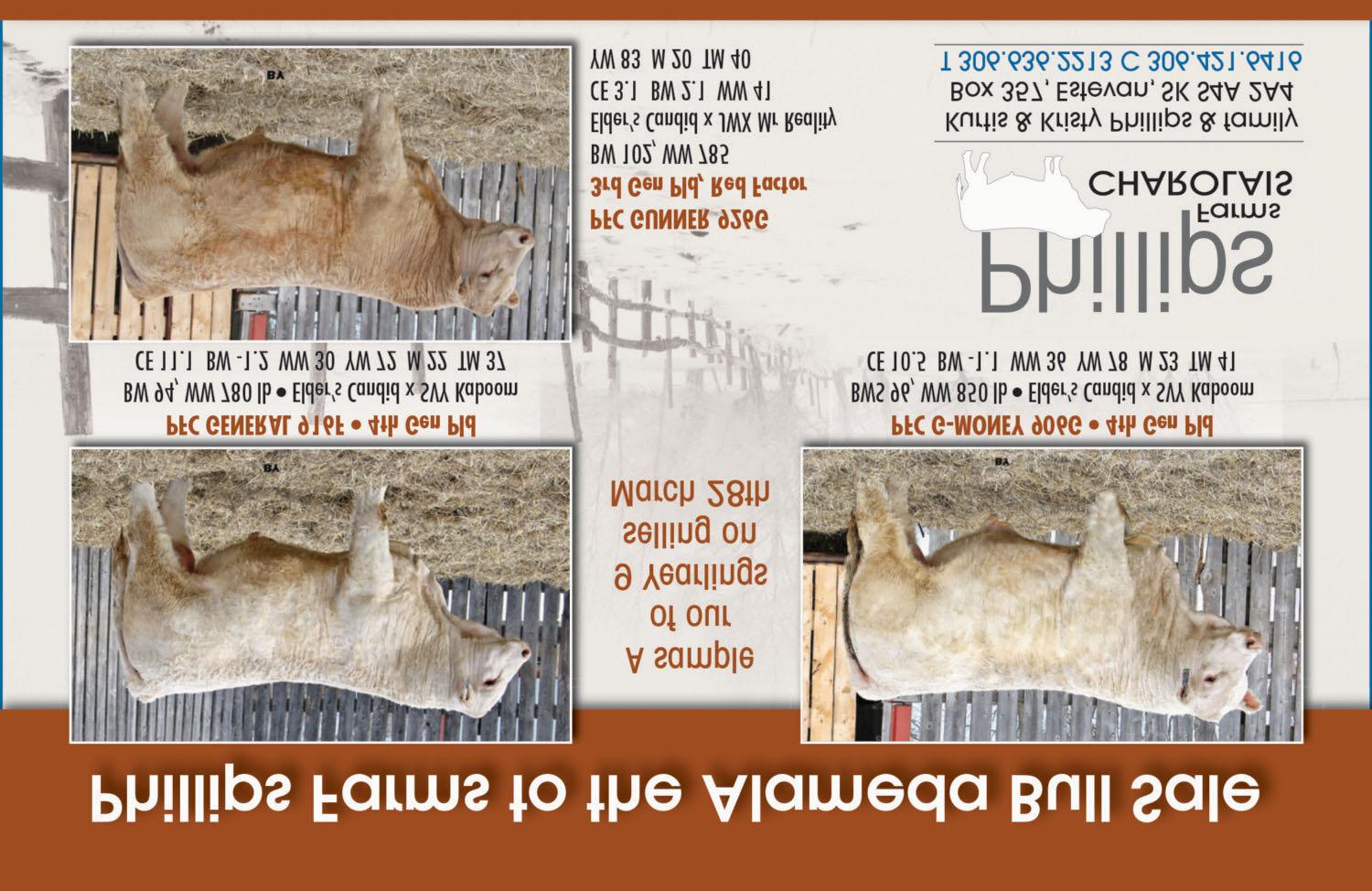
13 minute read
Profile – Deep Sands Livestock
David and Kim Gavelin, Deep Sands Livestock, calve around 150 breeding females. They used to run a purebred Gelbvieh herd but they have not been involved in the purebred industry for about five years. There are still purebred females in the herd, but they are no longer papered. Their kids dabble in it still, but their main business is their commercial cow/calf business.
They try to breed as many as they can Charolais. Every Charolais calf born in their operation is sold as they believe Charolais is a terminal cross. All steers and heifers that will not be kept for replacements are also sold. “We breed the Gelbvieh females Red Angus and our Red Angus females Gelbvieh for replacement females. We like to have Gelbvieh x Red Angus females to breed Charolais. We do buy some replacements, but it is difficult to always find what we want, thus we breed some ourselves. We only breed for 45 days. We turn our bulls out on June 1 and pull them on July 15th, or thereabouts. We put 30 females in the Meyronne community pasture, but the rest are pastured close to home on our own land,” explains David.
Advertisement
“When buying bulls I remember that we sell everything off the cow, so 205-day weight is really important to me. I try not to go under a 90-95 pound birth weight, but I prefer 110- 115 pound birth weight. I prefer a polled bull, but I will buy a horned bull if I find one I like. Temperament is a real deal breaker. When the kids were smaller, it was very important and we just stuck with it. A cow only gets one chance to do something stupid and she is gone. Feet structure is also important.”
“Everybody talks about calving ease, but you just need to look at the phenotype of how the bull is made. Until we were in the purebred business, we had no idea what calves weighed. I think most commercial guys would be shocked at the weight of their calves. I remember one time when a neighbour came over and I was going to weigh a newborn bull calf. I asked him what he thought the calf would weigh. He said maybe 80 pounds, but he wasn’t sure if it would be that much. I said I bet he wouldn’t be much under a hundred pounds and he was shocked when he weighed
97 pounds. I think a lot of people that think they are having 60 pound calves aren’t weighing them. A sixty pound calf is actually pretty disappointing. They start small and they tend to stay small. It is hard to find those curve benders that start small and manage to perform with the rest of the calves. I want my Charolais calves to weigh 110 to 115 pounds at birth. I do wonder about the Charolais breed chasing the calving ease. I hope they don’t go too far as I think their place in the industry is to be a terminal cross.”
“If you ask guys if they ever weigh their calves, many will say no. They won’t believe their calves are larger than sixty pounds. They talk about big, slow Charolais calves, and maybe that was true 25 years ago, but we never have trouble with our 110 lb calves getting up and sucking. I know that if there is a cold night and I miss something and they don’t get up right away, that 110 lb calf is going to stand continued on page 18
Just weaned replacement heifer calves A typical Gelbvieh female used in the program


a chance to live at least. That 60 lb calf will be dead by morning.”
“We weigh anything we think we might keep for a replacement female. We don’t keep any females with birth weights over 100 pounds. Everybody thinks if you have calving problems, it is the bull’s fault. The cow has at least fifty percent of the equation and she has all of the environmental factors influencing the calf, so she probably carries sixty percent of the equation. We don’t have small cows, our mature cows weigh around 1400–1500 pounds.” “When we started breeding Charolais on our cows, we started with a pretty heavy birth weight and had no problems because he was built right. We use a Red Angus cow bull on our females and a Gelbvieh bull on our heifers. I found a few years ago I could buy a Red Angus cow bull a lot cheaper than I could buy a Red Angus heifer bull,” David laughs.
“We usually only keep replacements

out of our mature cows, as our heifers have been bred to a heifer bull. If we source replacements we try to buy Gelbvieh females and breed them Red
Angus. It seems to work better than the a Gelbvieh bull on a Red Angus female. We were a little disappointed this year in the calves from our heifers, but the feed shortage last year was a factor. Some of the feed we sourced wasn’t the greatest either, it all adds up.”
“I don’t know if there is a huge difference in the weight of our calves by breed, but there definitely is in the price. We try to hand pick the maternal cows from which we hope to retain replacements and breed accordingly. Our biggest complaint in our Charolais bulls is that they don’t have all bull calves.”
“Our buckskin heifers will bring as much or more as some average steers. There is probably five to seven cents difference. Last year I went to pick up my cheque after the sale and started talking to a guy in the line. I told him I had started using Charolais bulls about ten years ago. He said you couldn’t have convinced me to use a Charolais bull, but I had some cows in a pasture where there were Charolais bulls and now after watching the sale, I am going to buy more.”
“We do an overnight stand in Moose Jaw to sell. We will lose eight to nine percent of their weight through the weaning, shrink and
continued on page 20


Craig Gavelin

Erin’s last Charolais steer


Erin’s graduation

traveling process. We had quite a few that weighed over 700 lb before weaning this year. What your calves bring in dollars per pound means nothing if you don’t calculate it with their weight. The price by itself is meaningless.”
“There were a few black Gelbvieh females in the herd that were Kade’s and Chayce’s (their sons) projects. They have competed in the Swift Current regional for years. This year, the clubby calves came more into play. It is rather sad really, no one is going to go raise a liner load of clubby calves to sell, it isn’t really relevant to the industry.”
Chayce is 26 and worked four years in EMS in Swift Current as a paramedic before switching careers. He is now in his third year of an Agricultural degree. Craig is 24 and he worked three years as a paramedic in Strasbourg before switching to Electrical Engineering and he is in third year. Erin is 22 and has started Addictions Counseling in Prince Albert. Kade is in grade 12 and as of now, is planning to study Engineering at the University of Saskatchewan. They have all participated in 4-H and Kade remarked this year that he has never missed a Swift Current Fair since he was born. He went as a baby as his siblings were participating.
Kim does books for the Co-op in McCord and David works for Sask Crop Insurance. “I have worked for them for 13 years. I call it my BSE job, now I call it my four kids in university job. We didn’t have a lot of grainland, so we either had to get bigger or give it up. I preferred the cattle to grain farming so that made the decision easy.”
They were in purebred Gelbvieh for close to fifteen years. They sold bulls off the farm and eventually sold some in the Top Cut Bull Sale in Mankota. We made a lot of good friends in the purebred business and still keep in touch with many of them.
“When the kids left home we had less help and didn’t have large purebred numbers, we didn’t feel we had the critical numbers to make it work. I have always believed that if you have a commercial herd, there really is no reason to run straight bred cattle. The cheapest way to make money in the cattle business is hybrid vigour. So we started using Red Angus on the Gelbvieh cows. Then after watching sales for a while, Kim said, ‘we just can’t afford to give money away. We need to use Charolais bulls.’ We started with one Charolais bull on 25 cows. If I knew we could consistently source our replacement females from outside our herd, I would breed everything Charolais. We are getting some more pounds out of the Charolais, but the biggest difference is the five to seven cent premium on that calf. It starts to add up.”
“We stay with the Gelbvieh because of their fertility and docility. The 45 day breeding window has really helped. We maybe took a bit of a hit in the first year, but now 75-80 percent of our females calve in the first cycle, so that buys the calves another thirty days of growth before weaning. The Charolais breed has come a long way, they still have performance but they are built to calve. It is important to us
continued on page 22





because we both work and the kids are active. We can’t be babysitting them, we don’t live with them. Yes, if it is really cold or the weather is miserable, we will check more, but if conditions are good, they should be able to do it themselves. We never had any trouble when we switched to Charolais bulls.”
“We raise as much of our own feed as possible. The last couple of years we sourced more because of the dry conditions. We also buy pellets as we don’t grow any grain. We probably purchase about a third of our feed. The cow herd picks on left over stubble and grass in the fall and if the snow doesn’t get too deep and we feed them pellets everyday, we can keep them out until Christmas.'
David was raised in McCord, but after marrying Kim in 1991, they purchased their farm near Meyronne in 1993. Their kids all attended Kincaid school and participated in hockey, 4-H and school sports. “Kim was an assistant leader in 4-H and I was a project leader for a while. I will miss that part of the industry when Kade is gone.”
They are currently at the capacity of their land base’s capability. Expanding a bit would be nice, but pasture land just isn’t easy to come by. It would also mean one of them would have to work less as next year it will only be the two of them at home. Through his work with crop insurance he has discovered that people that run a mixed operation are just a little easier to deal with. “They seem to be more rounded and take things in stride. I think cows
22 Charolais Connection • March 2020 have taught our kids some life skills and patience. They all still like the cows and they participate in whatever way they can. Chayce is a beef leader for a local 4-H club and they all showed up at Swift Current to watch their brother Kade show this year.”
At one time they had 80-90 ewes to help clean up some leafy spurge. Kim grew up with sheep. ‘We bought 25 sheep one year and kept them fenced in an area close to home. Within a week, we were down to 8, as coyotes kept taking them. We haven’t had coyote problems with our calves. Some time we may consider sheep again, you never know.”
“We sell in Moose Jaw in a Charolais and Simmental sale. The last few years, all of our calves sold in continued on page 24

the first 25 minutes of the sale. That is really satisfying. The most important thing to consider in your profit margin is pounds per cow exposed. I don’t want too many people to catch on about how much more money they can make with these tan calves, because I don’t want the market saturated. But people are funny, they just won’t take a chance and try anything different than they have always done. Where we make up the biggest difference is on good tan Charcross heifers. There is not near the penalty on those heifers as there is on any other breed. When your numbers aren’t big you have to get as much as you can out of each animal to maximize your profit. I strive for quality over quantity. There isn’t room for a large margin of error in the industry. If you can find another five cents per pound and find another 25

pounds, you have really increased your profit margin.”
They use a computer program called Ranch Manager. It tracks cows individually which allows you to make better management decisions. The calves are weighed a week before weaning.
“I learned in the purebred business to not criticize other people’s breeds or choices. People do what works for them and their situation. Every breed has its benefits. What works for one person, won’t work for another. For us, it is the three way cross, a Gelbvieh x Red Angus female with a Charolais bull.”

















